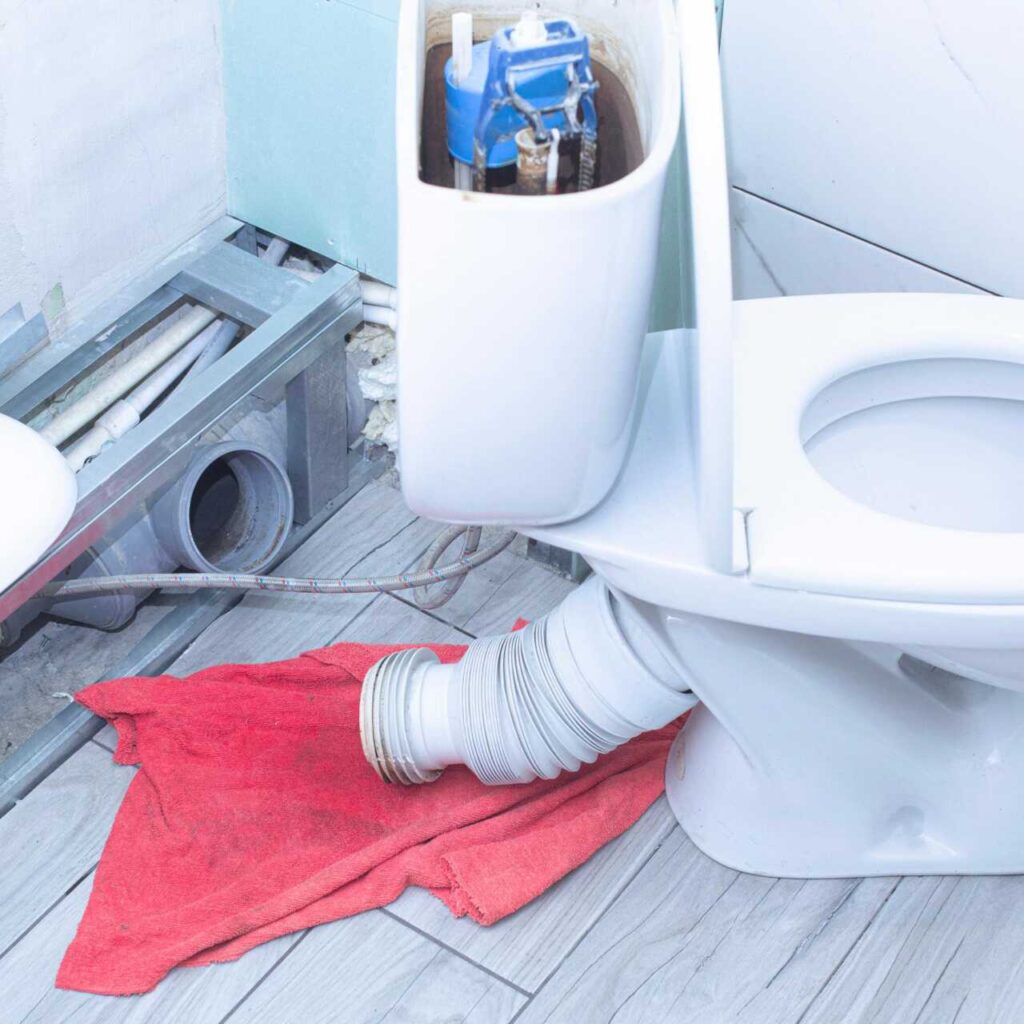
Contents
When faced with a sewage backup, your first priority should be to assess the situation and ensure safety. Identify the type of sewage involved, as this will dictate your next steps. You’ll need to shut off the main water supply to prevent further issues. Remember, wearing appropriate protective gear is essential for your safety. But what comes next may surprise you, as addressing the aftermath requires a systematic approach.
Key Takeaways
- Assess the sewage type and ensure safety by wearing protective gear and isolating affected areas.
- Shut off the main water supply to prevent further sewage entry and inspect plumbing for issues.
- Remove standing water using appropriate tools and ensure proper drainage to prevent return.
- Clean and disinfect all affected surfaces with commercial-grade disinfectants, following manufacturer instructions.
- Engage professional restoration services for thorough cleanup, health safety, and preventive measures against future incidents.
Assess the Situation and Ensure Safety
Before you begin any cleanup after a sewage backup, it’s vital to assess the situation and ensure your safety.
Start by identifying the sewage types involved: graywater, which contains waste from sinks and showers, poses fewer health risks, while blackwater, from toilets, carries severe pathogens. Make sure to wear protective gear, including gloves, masks, and boots, to avoid direct contact with contaminants.
Next, evaluate the area for hazards such as electrical issues or structural damage. If the sewage has flooded multiple rooms, isolate the affected zones to prevent contamination spread.
It’s important to be aware of the health risks associated with exposure to sewage, including gastrointestinal infections and respiratory issues. If you suspect severe contamination or if the situation feels overwhelming, don’t hesitate to call in professionals.
Shut Off the Water Supply
Shutting off the water supply is an essential step in managing a sewage backup. You’ll want to locate your main water shutoff valve, typically found near the water meter or where the water line enters your home. Turn the valve clockwise to stop the flow of water. This action prevents additional sewage from entering the system, allowing you to control the situation effectively.
After the water shutoff, consider conducting a plumbing inspection to identify any underlying issues that may have contributed to the backup. Look for signs of wear or damage in pipes, joints, and fixtures.
If you’re unsure about the inspection process, consulting a professional plumber can provide peace of mind and ensure your plumbing system is functioning correctly.
Taking these steps protects your home and fosters a sense of community as you share your knowledge and support others facing similar challenges.
Wear Protective Gear
After you’ve shut off the water supply, the next step is to prioritize your safety by wearing protective gear.
It’s vital to equip yourself with appropriate protective clothing such as waterproof gloves, rubber boots, and a full-body suit to prevent skin contact with hazardous materials.
Safety equipment, including a respirator or mask, is essential to shield yourself from harmful bacteria and fumes that may be present in sewage.
Eye protection like goggles will help safeguard your vision from splashes and debris.
Confirm all gear is in good condition and fits properly; any gaps can expose you to contaminants.
By donning this protective gear, you’re safeguarding your health and demonstrating a commitment to a safe and responsible cleanup process.
Remove Standing Water
One of the first tasks in tackling sewage backup is to remove standing water as quickly and efficiently as possible.
Begin by evaluating the area to determine the depth of standing water. Use a submersible pump or a wet/dry vacuum to facilitate water removal. If the water is significant, a pump is generally the best option, as it can handle larger volumes and can be operated continuously.
Make sure you have a proper drainage system in place to prevent water from returning to the area. If you’re using a wet/dry vacuum, ensure it’s equipped for handling liquids.
As you remove standing water, keep an eye out for any hazardous materials or debris. Working methodically will help you achieve a thorough cleanup.
Once the water is gone, you can prepare for the next steps in the sewage backup cleanup process, ensuring a safe and effective environment as you proceed.
Clean and Disinfect Affected Areas
Before you begin cleaning and disinfecting the affected areas, make certain you’re wearing appropriate personal protective equipment, such as gloves and masks, to minimize exposure to harmful pathogens.
Once you’ve prioritized safety, use effective disinfection methods, like commercial-grade disinfectants or a bleach solution, to thoroughly sanitize surfaces.
This process eliminates contaminants and helps prevent future health risks associated with sewage exposure.
Safety Precautions First
While addressing a sewage backup, prioritizing safety during the cleanup process is essential to prevent health risks and further contamination.
Start by gathering appropriate safety equipment, including gloves, masks, and protective eyewear, to shield yourself from harmful pathogens. It’s vital to avoid direct contact with sewage and contaminated surfaces.
Before beginning, make certain you’ve informed your emergency contacts about the situation; they may provide valuable assistance or advice.
Ensure proper ventilation in the area to minimize exposure to harmful fumes. If the situation seems overwhelming or hazardous, don’t hesitate to call professionals who specialize in sewage cleanup.
Prioritizing these safety measures protects you, your loved ones, and your community from potential health hazards.
Effective Disinfection Methods
After ensuring your safety, the next step is to effectively clean and disinfect the affected areas to eliminate harmful pathogens and prevent future contamination.
Utilizing appropriate disinfection techniques is essential for microbial control. Here are some methods to take into account:
Use EPA-approved disinfectants: Choose products specifically designed for sewage cleanup.
Apply bleach solutions: A mixture of one cup of bleach per gallon of water can effectively disinfect surfaces.
Steam cleaning: This method can reach high temperatures to kill bacteria.
Hydrogen peroxide: Use it as an alternative disinfectant for porous surfaces.
UV light sanitizers: These can effectively eliminate pathogens without chemicals.
Always follow the manufacturer’s instructions and allow sufficient contact time for disinfectants to work effectively.
Dispose of Contaminated Materials
When dealing with sewage backups, promptly disposing of contaminated materials is crucial to prevent health risks and further contamination.
Begin by identifying all contaminated waste, including carpets, insulation, drywall, and any porous items. These materials can harbor pathogens, so it’s important to act quickly. Wear protective gear—gloves, masks, and boots—before handling any contaminated items.
Next, seal these materials in heavy-duty plastic bags or containers to avoid spills during transport. Check local regulations for proper disposal methods, as some areas require special handling for hazardous waste. If you’re unsure, consult a professional waste disposal service experienced in hazardous materials.
After disposal, thoroughly clean and disinfect all surfaces that come into contact with sewage. This proactive approach safeguards your health and ensures a cleaner, safer environment for everyone involved.
Restore and Repair Damaged Structures
Once you’ve disposed of contaminated materials, it’s essential to assess the structural damage to your property.
Inspect walls, floors, and ceilings for any signs of weakening or compromised integrity, as this will inform your repair strategy.
Replace any contaminated materials to ensure a safe and healthy environment moving forward.
Assess Structural Damage
Evaluating structural damage is an essential step in the aftermath of a sewage backup, as it directly impacts the safety and integrity of your property.
Conducting a thorough damage assessment helps you identify areas that need attention. Here’s what you should check:
Foundation: Look for cracks or shifting.
Walls: Inspect for warping, discoloration, or mold.
Floors: Check for buckling or soft spots.
Ceilings: Watch for sagging or water stains.
Electrical Systems: Verify wiring and outlets are safe and undamaged.
Replace Contaminated Materials
Replacing contaminated materials is vital for restoring your property to a safe and healthy state after a sewage backup.
Begin by identifying all affected areas, including drywall, carpeting, and insulation. These contaminated materials can harbor harmful pathogens, so they must be removed promptly.
When considering replacement options, choose materials that are resistant to moisture and mold growth, such as treated wood or vinyl flooring.
Confirm that all surfaces are thoroughly cleaned and disinfected before installing new materials.
It’s essential to work with professionals who specialize in sewage damage restoration to ensure proper procedures are followed.
This proactive approach protects your health and re-establishes the comfort and safety of your living environment.
Wrap-Up
While dealing with a sewage backup may not be on anyone’s bucket list, handling it properly can prevent a minor disaster from turning into a major catastrophe. You’ve navigated the mess by evaluating the situation, wearing protective gear, and cleaning up like a pro. Just remember, a little irony goes a long way: sometimes, the “crappy” moments in life teach us the most about maintaining a safe and healthy home. Keep that in mind next time!
Recent Posts
Rapid Water Damage Restoration Solutions Available Now
When water damage strikes, every minute counts. You need to act fast to minimize destruction
What Are the Best Emergency Water Removal Services?
When evaluating the best emergency water removal services, it’s crucial to focus on their response
How to Find 24/7 Emergency Water Removal Services
When you’re facing a water emergency, knowing how to find reliable 24/7 water removal services
